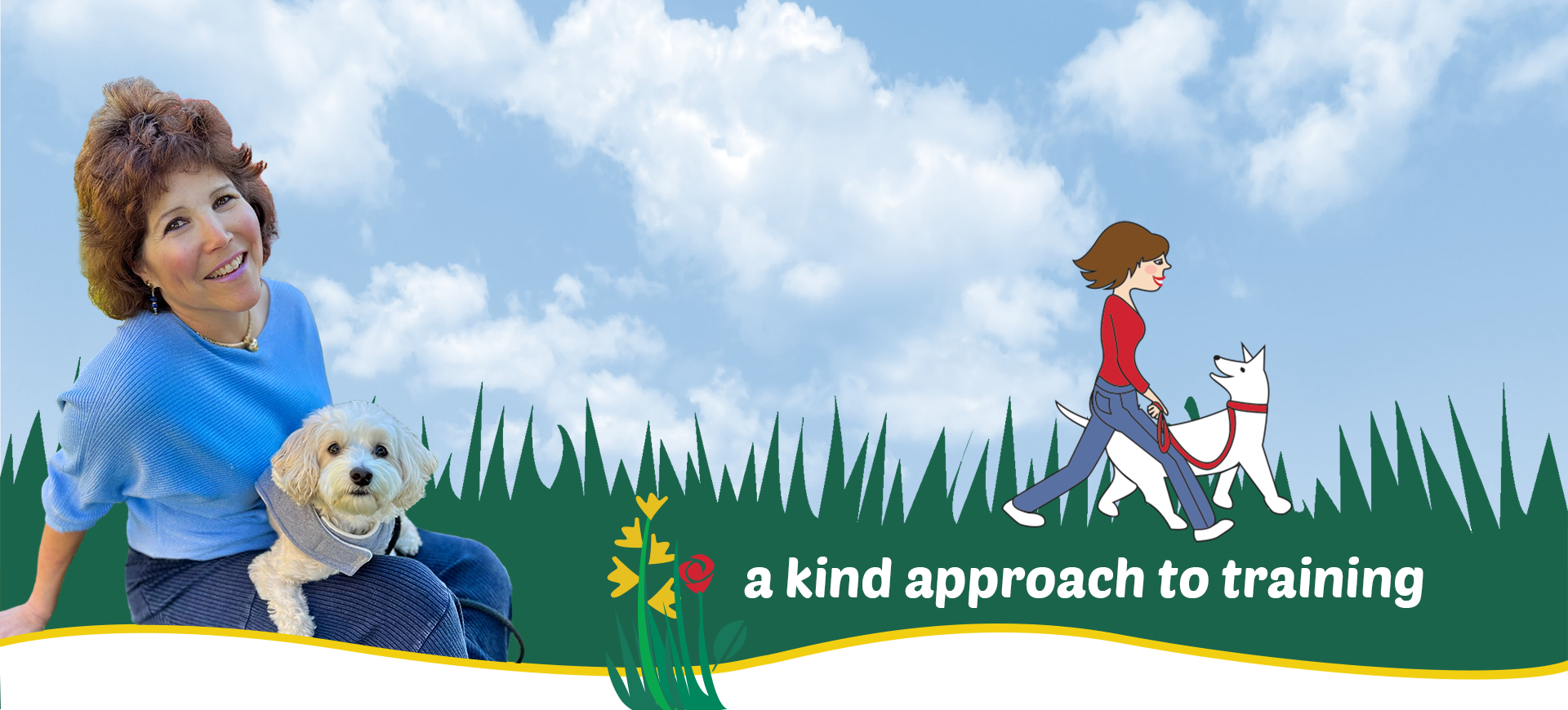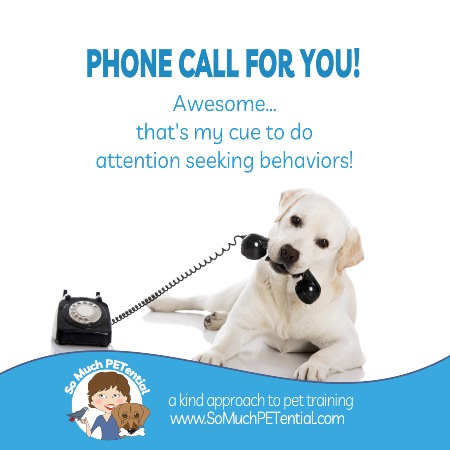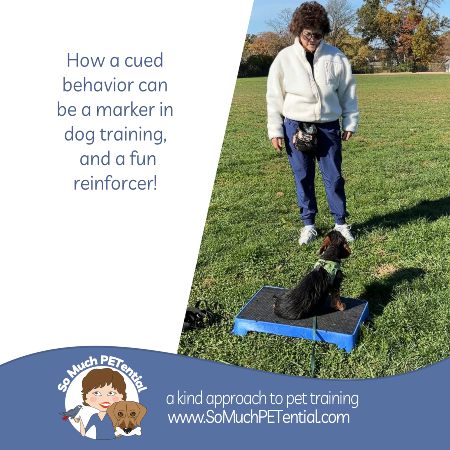I often hear complaints from people about their reactive dog lurching to the end of a taught leash and/or barking at stimulus such as dogs, people or cars. They are frustrated. They want to be able to take a long walk with their dog by their side – no pulling, no barking (and especially no growling or worse), and no planting of feet to stop moving in a certain direction.
 I get it. The reason we have pets is for their companionship. Doing shared activities bring us closer together. Socially, dog owners may also enjoy running into people they know (or meeting new people) while out and about with their dog. Often when I ask new clients about their dog’s exercise, a daily walk or two is their pet’s main physical activity. That walk is so important to them on so many levels.
I get it. The reason we have pets is for their companionship. Doing shared activities bring us closer together. Socially, dog owners may also enjoy running into people they know (or meeting new people) while out and about with their dog. Often when I ask new clients about their dog’s exercise, a daily walk or two is their pet’s main physical activity. That walk is so important to them on so many levels.
I have written before about some reasons why there may be a break down in loose leash walking. I wanted to specifically address a few of my observations of clients with those specific dog training problems.
One client and his large dog had just walked out the front door when his dog stopped and looked back toward the house. As soon as my client pulled on the leash – an action he thought would encourage his dog to move forward – I saw his dog lick her lips before sitting down, hunching her back and looking away from him.
These are stress signals in a dog, indicators that, in that moment, the dog is not feeling comfortable. And, if a dog is feeling stressed, trigger stacking will cause it to be more likely to bark, lunge, growl, or try to escape when certain stimuli are present.
When we were in the yard, even when a loose leash was between my client and his dog, and there was food involved, his dog was avoiding eye contact with him and moving away from him.
There was a reason for this. In the past, my client had applied leash pressure when his dog would begin barking at fast moving people or dogs – a common reaction from people when their dog reacts to things while on a walk. From what I had observed, that leash tension was not a positive thing for his dog. And, experience has taught his dog that when she is attached to a leash with her owner on the other end, that there is a possibility (probably a good possibility) that leash tension will occur since they live on a busy street.
This is known as associative learning. It is a general term referring to the process whereby learned associations are formed between stimulus. It includes both operant conditioning where behaviors are learned, strengthened or weakened, or modified based upon the consequences of those behaviors; and classical conditioning, which is a reflexive or automatic type of learning.
When it was my turn to demonstrate, I took the leash as someone who does not have that history associated with me. His dog walked alongside me with loose body muscles, her tail in a loose position, and paying attention to me. I asked her to sit and hand target, which she did without hesitation. I had treats in a treat pouch, and, as she took a few steps with me, sat or hand targeted when asked, I marked those behaviors (with ‘yes’) and then gave her a treat. Looking at passers-by with loose muscles also was marked, and then reinforced. She showed none of those stress signals. NOTE that those people were on the other side of the street. I was careful to stay at a distance from them where she could continue to show calm body language.
Several years ago I wrote about a research study that found dogs who were trained using aversive training methods were 15 times more likely to show symptoms of stress than those dogs who were trained using positive reinforcement. There was a HUGE difference in the dogs’ amount of spontaneous gaze to its handler between those who used negative vs positive reinforcement in training loose leash walking. What happened on that day with my client was a clear example of this.
I am remembering another day with another client and his dog. We were standing on the sidewalk when a neighbor a few houses away came outside. As soon as his dog saw the other man, she began to bark and ran to the end of the leash. My client stood in front of her, telling her over and over in his stern voice to lay down. However, she continued to bark while attached to a very taught leash that was holding her back. No doubt her heart rate was elevated as her only focus was on that other person in her sight. She most definitely was not in ‘look and think’ mode.
The beautiful thing is that when my client learned to use positive reinforcement in training his dog to walk with him on a leash, his dog also no longer reacted with barking and lunging to seeing people. In fact, his dog also had loose body muscles during the entire ‘short’ walk and her focus was on the man holding the other end of her leash.
With both of these clients, as with anyone frustrated with their dog doing behaviors they think are bad while on a leash, it is important for them to think in terms of short term and long-term goals. If they want to be able to take their dog on a walk around the neighborhood, time needs to be spent upfront teaching their dog in the most positive way that focusing on and walking beside them, and doing behaviors they want their dog to do results in really good things (from your dog’s perspective). This includes learning how to recognize and understand their dog’s body language and arousal level. And only increasing the difficulty of learning as their dog can continue to succeed.
Additionally, if your dog’s behaviors are rooted in a medical condition, fear, resource guarding or territorial aggression, it is imperative that those underlying issues be addressed too. A professional dog trainer can help.
Feeling safe is critical for the capacity to learn, and for quality of life. It is important to understand how your dog communicates so that when he is fearful and/or stressed you can take action to de-stress him (whether that be giving him distance from the aversive stimulus, stopping what you are or someone else is doing, and teaching him that good things can happen in that environment).
I thought I’d leave with a couple last thoughts. Long neighborhood walks on leashes are not the only way to enjoy the outdoors with your dog. In fact, some dogs would prefer to stay at home or do other things. Consider a sniffing outing or a walk through the woods or a pasture; or a game or foraging activity. There are so many fun and creative ways to get exercise and have quality time with your pet!







